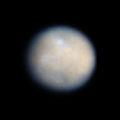
Pas de plus haute résolution disponible.
Ce fichier provient de un dépôt partagé et peut être utilisé par d'autres projets.
Sa description sur sa page de description est affichée ci-dessous.
Summary
This is a NASA Hubble Space Telescope color image of Ceres, the largest object in the asteroid belt.
Astronomers enhanced the sharpness in these Advanced Camera for Surveys images to bring out features on Ceres' surface, including brighter and darker regions that could be asteroid impact features. The observations were made in visible and ultraviolet light between December 2003 and January 2004.
The colors represent the differences between relatively red and blue regions. These differences may simply be due to variation on the surface among different types of material.
Ceres' round shape suggests that its interior is layered like those of terrestrial planets such as Earth. Ceres may have a rocky inner core, an icy mantle, and a thin, dusty outer crust inferred from its density and rotation rate of 9 hours. Ceres is approximately 590 miles (950 kilometers) across and was first discovered in 1801.
Copyright status
Credit: NASA, ESA, J. Parker (Southwest Research Institute), P. Thomas (Cornell University), L. McFadden (University of Maryland, College Park), and M. Mutchler and Z. Levay (STScI). Public-domain images from NASA.
Source
NASA/ESA, http://imgsrc.hubblesite.org/hu/db/2005/27/images/d/formats/full_jpg.jpg
Historique du fichier
Cliquer sur une date et heure pour voir le fichier tel qu'il était à ce moment-là.
| Date et heure | Vignette | Dimensions | Utilisateur | Commentaire |
|---|
| actuel | 23 janvier 2008 à 03:34 |  | 250 × 250 (50 kio) | Temlakos | This is a NASA Hubble Space Telescope color image of Ceres, the largest object in the asteroid belt. Astronomers enhanced the sharpness in these Advanced Camera for Surveys images to bring out features on Ceres' surface, including brighter and darker reg |
Utilisation du fichier
Les 2 pages suivantes utilisent ce fichier :
Ce fichier contient des informations supplémentaires, probablement ajoutées par l'appareil photo numérique ou le numériseur utilisé pour le créer.
Si le fichier a été modifié depuis son état original, certains détails peuvent ne pas refléter entièrement l'image modifiée.

